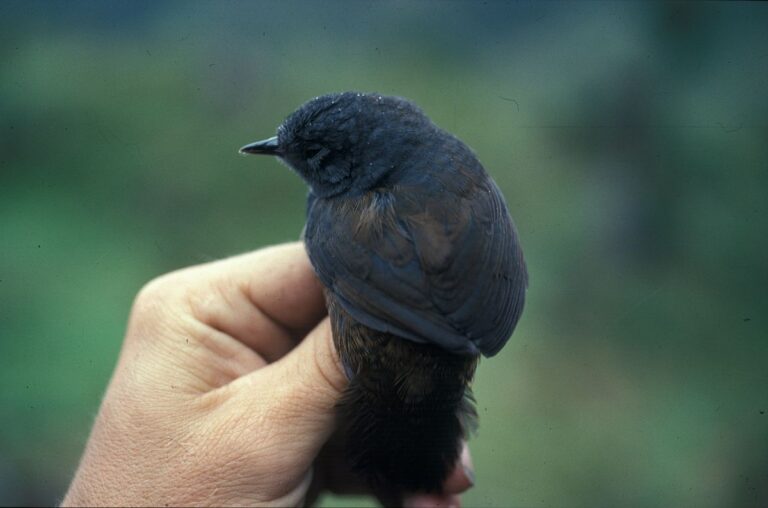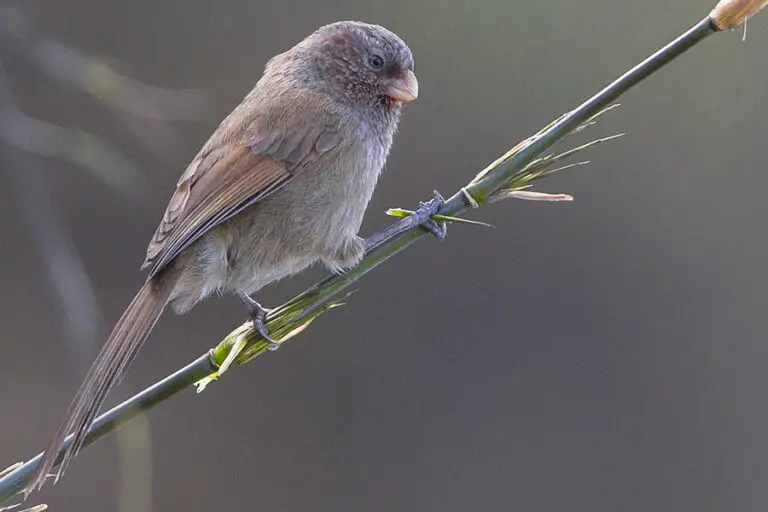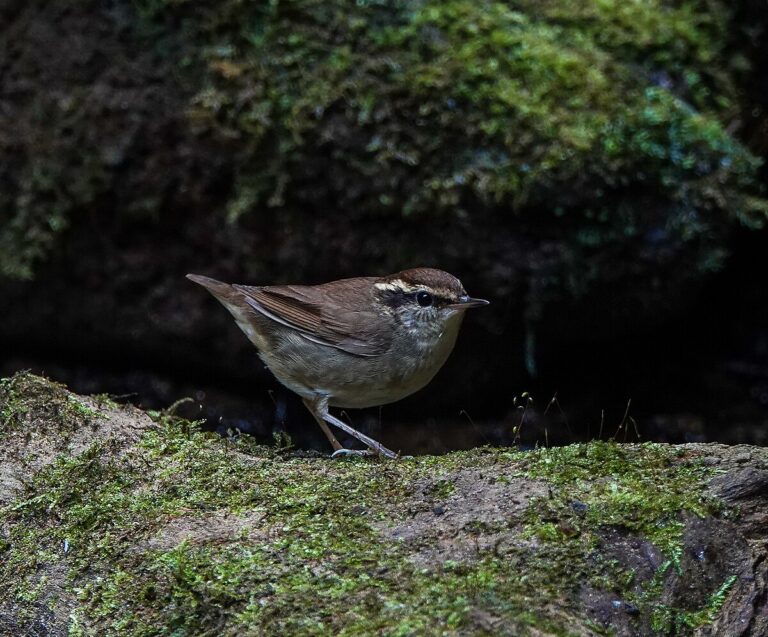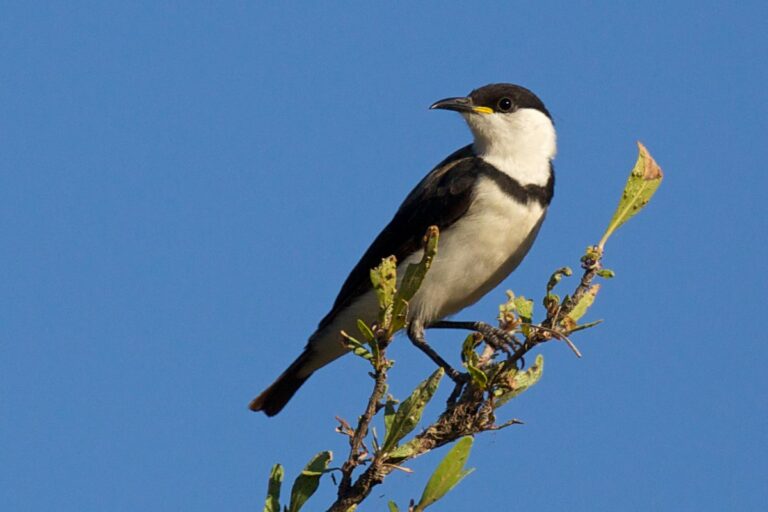Zebra Finch (Taeniopygia guttata)
“The male zebra finch creates a unique song by drawing inspiration from its parent or tutor”
Here’s the scientific classification and conservation status of the Zebra Finch (Taeniopygia guttata):
- Kingdom: Animalia
- Phylum: Chordata
- Class: Aves
- Order: Passeriformes
- Family: Estrildidae
- Genus: Taeniopygia
- Species: Taeniopygia guttata
Conservation Status: The Zebra Finch is classified as “Least Concern” by the International Union for Conservation of Nature (IUCN), indicating that it is not currently facing significant threats to its population.
Locations: Zebra Finches are found in Asia and Oceania, inhabiting a range of environments such as grasslands, savannas, and shrublands across these regions.
Facts about the Zebra Finch:
- Prey: Zebra Finches have an omnivorous diet, feeding on seeds, fruits, vegetables, and insects.
- Fun Fact: Male Zebra Finches create unique songs, drawing inspiration from their parents or tutors.
- Estimated Population Size: The population size of Zebra Finches is unknown.
- Biggest Threat: Predators pose the greatest threat to Zebra Finches.
- Most Distinctive Feature: Their speckled or striped plumage along the sides and tail is their most distinctive feature.
- Wingspan: Zebra Finches have a wingspan of 8-9 inches.
- Incubation Period: The incubation period for Zebra Finch eggs is approximately 2 weeks.
- Habitat: They inhabit savannas and grasslands.
- Predators: Zebra Finch predators include marsupials, snakes, mice, and birds of prey.
- Diet: Zebra Finches are omnivores.
- Type: They are birds.
- Common Name: Zebra Finch.
- Number of Species: There is one species of Zebra Finch.
- Location: Zebra Finches are found in Australia and Timor.
- Nesting Location: They nest in trees, bushes, or burrows.
- Age of Molting: Zebra Finches molt at around 3 weeks of age.
Physical Characteristics:
- Color: Zebra Finches display various colors including grey, red, black, white, and orange.
- Skin Type: Their bodies are covered in feathers.
- Weight: Zebra Finches weigh approximately 12g.
- Length: They measure around 4 inches in length.
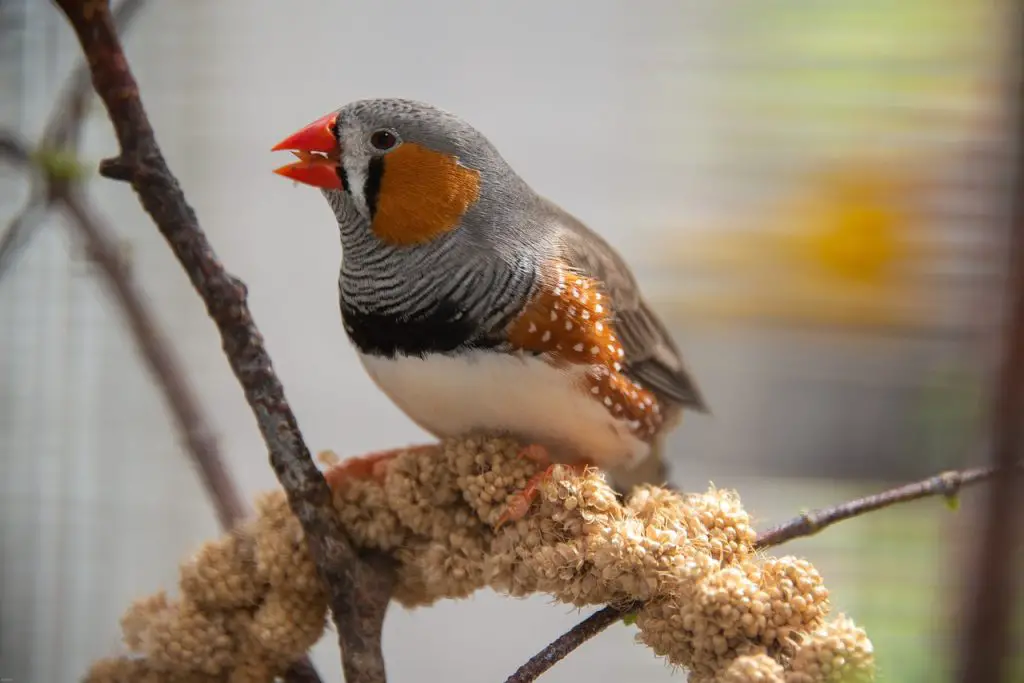
The Zebra Finch, a petite songbird, hails from the southern Pacific region and is formally classified among the estrildid finches. Perched on branches or logs, the male serenades prospective mates with a unique composition crafted by himself. This charming courtship behavior, along with their gregarious nature and cheerful, almost conversational vocalizations, makes them a common sight in the wild and a favored choice in the exotic pet trade.
5 Amazing Zebra Finch Facts
- Model Organism: Zebra Finches serve as a model organism in scientific research, offering insights into mating behavior, social interactions, and vocalizations of closely related estrildid finches. Scientists study them extensively to understand various aspects of avian behavior and communication.
- Unique Song Composition: Male Zebra Finches are capable of composing unique songs, a behavior that has drawn significant scientific interest. Researchers have studied their genome to explore the genetic basis of this ability, which has implications for understanding the evolution of human speech. Mutations in key genes can lead to changes or impairments in the bird’s vocalizations.
- Historical Discovery: The Zebra Finch was first described by the French ornithologist Louis Jean Pierre Vieillot in 1817, marking its initial documentation in scientific literature.
- Genome Sequencing: Zebra Finches were among the first birds to have their entire genome sequenced, providing valuable genetic information for further research and comparative studies.
- Human-like Mating Behavior: Zebra Finches exhibit intriguing parallels with human mating behavior. There’s a discernible tension between fidelity and infidelity in their mate selection process. Studies suggest that freely chosen mates result in higher chick survival rates, indicating the potential role of attraction in their relationships. While this hypothesis requires further investigation, it highlights the complexity of avian social dynamics and parenting behaviors.
Habitat
The Zebra Finch originally hails from the dry savannahs and grasslands of Australia and Timor, a Pacific island shared between Indonesia and East Timor. Despite its humble origins in these regions, the Zebra Finch has achieved global distribution as a popular domestic pet.
Thanks to its charming appearance, cheerful demeanor, and melodious songs, the Zebra Finch has captured the hearts of bird enthusiasts worldwide. As a result, it has been widely bred and kept as a pet in households across the globe.
This widespread popularity as a domestic pet has led to the Zebra Finch being introduced to various regions outside its native range, where it continues to thrive in captivity. Thus, from its modest beginnings in the Australian and Timor grasslands, the Zebra Finch has become a beloved companion bird enjoyed by people of all ages and backgrounds around the world.
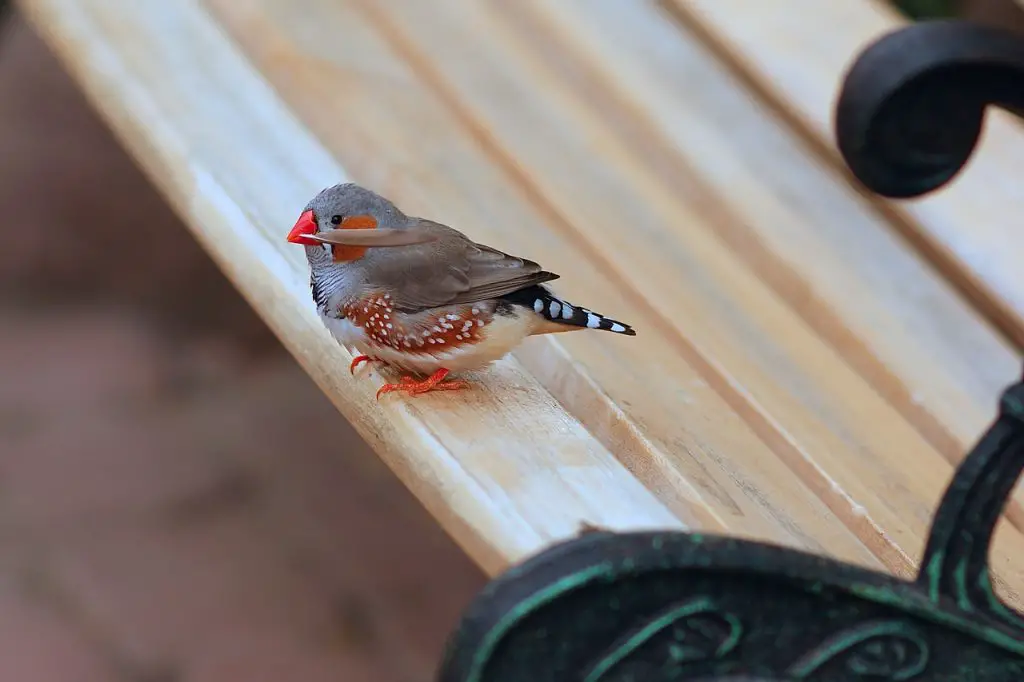
Zebra Finch Nests
Indeed, the Zebra Finch exhibits remarkable adaptability in nest construction, with the ability to create nests in diverse locations such as trees, bushes, or even burrows. Their nests are constructed using a variety of materials including grasses, feathers, and wool, providing a cozy and secure environment for incubating eggs and raising chicks.
This flexibility in nest building reflects the Zebra Finch’s ability to adapt to different habitats and environmental conditions, ensuring reproductive success in a range of landscapes. Whether perched in the branches of a tree, nestled within a bush, or tucked away in a burrow, Zebra Finches demonstrate resourcefulness and ingenuity in creating suitable nesting sites for their offspring.
Scientific Name
The Zebra Finch, scientifically known as Taeniopygia guttata, derives its species name “guttata” from the Latin term meaning “spotted” or “speckled,” likely referring to the speckled plumage along its sides and tail. Belonging to the family of tropical Australian/Asian finches known as estrildids, the Zebra Finch’s genus classification has been a topic of debate among experts.
While some experts have grouped the Zebra Finch and its closely related counterpart, the Double-barred Finch, within the genus Poephila, others advocate for a separate genus classification of Taeniopygia. Most analyses tend to support the latter notion, suggesting that both the Zebra Finch and the Double-barred Finch belong to their own distinct genus.
Furthermore, there are two recognized subspecies of the Zebra Finch: one originating from the island of Timor and the other from Australia. These subspecies exhibit slight variations in plumage and geographic distribution, contributing to the overall diversity within the species.
Evolution And Origin
The Zebra Finch, endemic to Australasia, shares a common ancestry with other members of the estrildid finches family, including the Black-throated Finch and the Masked Finch. The Zebra Finch began to diverge into its own separate species approximately 2.9 million years ago.
While the Zebra Finch has been classified in the same species as the Double-barred Finch in the past, genetic evidence suggests that these two bird species have been distinct entities for around 3.5 million years. This divergence likely occurred due to evolutionary pressures and environmental changes.
It’s believed that the two species of Zebra Finch, though initially evolving in what is now Australia, were likely separated by a glacial event that occurred over 2 million years ago during the Pleistocene era. This geographical isolation played a significant role in shaping the genetic and behavioral differences observed between the two species of Zebra Finch today.
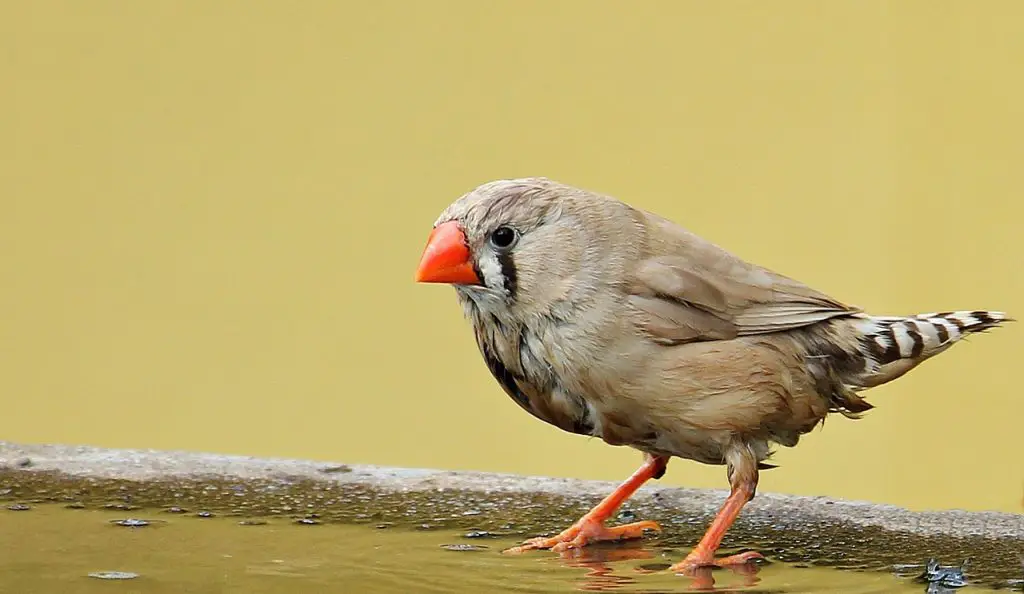
Types Of
It’s fascinating to note the taxonomic intricacies within the finch family, particularly within the genus Taeniopygia. The Zebra Finch, previously considered a single species, has been further classified into two distinct species by the International Union for Conservation of Nature (IUCN) in 2016.
The first species, the Australian Zebra Finch (Taeniopygia castanotis), is native to Australia, while the second species, the Sunda Zebra Finch (Taeniopygia guttata), is found in Indonesia, specifically on the island of Timor.
This taxonomic revision highlights the importance of ongoing research and conservation efforts in understanding and preserving avian biodiversity. As our understanding of species relationships and distributions evolves, it enables more effective conservation strategies to be implemented to protect these unique and diverse bird species.
Size, Appearance, And Behavior
The Zebra Finch, a diminutive bird measuring no more than 4 inches in length, features a plump body, short beak, and slender legs, perfectly adapted for its agile movements and precise feeding habits. Notably, the species exhibits strong sexual variation in plumage.
Male Zebra Finches boast an extraordinary patchwork of colors, including a gray hooded head, a striped black and white tail, distinctive orange patches on the cheeks and sides, and a striking red beak. In contrast, females display simpler gray-colored bodies with orange beaks.
Occasionally, novel mutations give rise to new color morphs, though they are rare in nature and seldom become fixed in populations. However, selective breeding by humans can amplify these mutations, resulting in unusual color combinations such as orange breasts, yellow beaks, black cheeks, or all-white plumage.
Zebra Finches lead a socially vibrant life, forming large flocks of up to 100 individuals (reducing to around 50 during breeding season). These flocks engage in various activities together, including hunting, roosting, and preening, often in close proximity to one another. While they may travel a few miles in search of food, flocks typically maintain a defined home range.
Known for their friendly and gregarious nature, Zebra Finches can recognize and distinguish other individuals within their flock, yet they may also chase away outsiders from their territory.
A fascinating aspect of Zebra Finch behavior is the male’s ability to create intricate songs to attract mates. They learn these songs from a father or male tutor and gradually develop their own variations over time. Interestingly, research suggests that they may even “lip sync” these songs in their sleep, potentially as a mechanism for storing long-term information about the song in their brains. While bird song is primarily a male behavior, both sexes are capable of producing complex sounds to communicate with each other.
Diet
The Zebra Finch is indeed an omnivorous bird, but it primarily consumes plant matter as the main component of its diet.

What Does The Zebra Finch Eat?
Indeed, the Zebra Finch’s diet is diverse, consisting of various types of seeds, fruits, vegetables, and insects. Their stout beaks are well-adapted for dehusking seeds, allowing them to efficiently extract the nutritious kernels within. This versatility in diet enables Zebra Finches to obtain essential nutrients from a range of food sources, contributing to their overall health and vitality.
Predators, Threats, And Conservation Status
Zebra Finches are currently classified as a species of least concern by the IUCN Red List. While they face threats from natural predators and diseases like many other bird species, they are not currently threatened by human activity. This favorable conservation status reflects the species’ widespread distribution, stable population, and ability to adapt to various habitats. However, ongoing monitoring and conservation efforts are essential to ensure the continued well-being of Zebra Finch populations, particularly in regions where habitat degradation or other anthropogenic factors may pose potential risks in the future.
What Eats The Zebra Finch?
Zebra Finches face predation from a variety of predators, including marsupials, snakes, and birds of prey. These predators pose a threat to both adult birds and their vulnerable eggs.
In addition to these predators, eggs laid by Zebra Finches are also targeted by mice, which consume them as a source of nutrition. This predation on eggs further highlights the challenges that Zebra Finches face in successfully reproducing and raising offspring in their natural environment.
Reproduction, Young, And Molting
Zebra Finches exhibit a highly flexible and opportunistic breeding strategy, influenced by environmental factors such as rainfall rather than a specific mating season. Upon the onset of favorable conditions, typically marked by significant rainfall, males engage in elaborate courtship displays, including intricate dances and unique songs crafted to attract mates.
Forming lifelong monogamous pair bonds, Zebra Finches construct nests and lay clutches of four to six eggs over several days. While the female incubates the eggs, the male diligently guards the nest. After approximately two weeks, the eggs hatch, giving rise to chicks adorned with a simple gray plumage resembling their mother.
Both parents take turns incubating the eggs and feeding the young, ensuring their growth and development. Within three weeks, the chicks begin to take flight, but it takes an additional two weeks before they become fully independent of their parents. After the departure of the chicks, the parents may initiate another round of breeding, laying another clutch of eggs.
Despite their attentive care, Zebra Finches have a relatively short lifespan, averaging two to three years in the wild. Many succumb to predation, disease, or accidents, particularly within their first year of life. However, when kept in human care, Zebra Finches may live longer, with an average lifespan of five to seven years, benefiting from the safety and security provided by their owners.

Population
While the exact population size of Zebra Finches in their wild habitat remains unknown, current observations suggest that their population numbers are relatively stable. Despite the lack of precise population data, there is no evidence to indicate significant declines or threats to their overall population health at this time.
The stability of Zebra Finch populations reflects their adaptability to various habitats, flexible breeding strategies, and ability to thrive in a range of environmental conditions. However, ongoing monitoring and conservation efforts are crucial to ensure the continued well-being of Zebra Finches, particularly in regions where habitat degradation or other anthropogenic factors may pose potential risks in the future.
Final Thoughts
The Zebra Finch is a remarkable bird known for its adaptability, social behavior, and intricate breeding strategies. With its striking plumage, unique courtship rituals, and melodious songs, it captivates both researchers and bird enthusiasts alike. While facing predation and environmental challenges, Zebra Finch populations remain relatively stable, reflecting their resilience in the wild. As a popular choice in the pet trade and a subject of scientific research, the Zebra Finch continues to intrigue and inspire, highlighting the importance of conservation efforts to safeguard its future.
